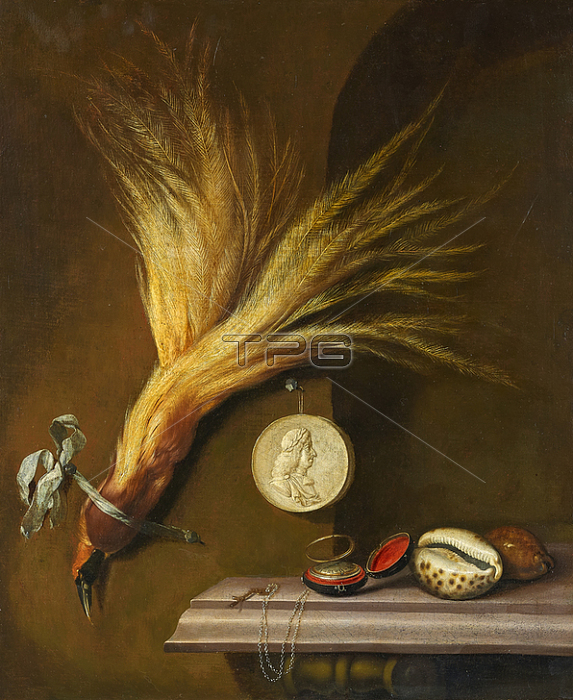
STEENWIJK; N.
Second half of the 17th century
Still life with bird of paradise; shells; a watch and a portrait medallion. Oil on canvas. Relined. 59;5 x 49;5cm. Framed.
Verso:
Old label attributing the work to Nic. Steenwijk jun. on stretcher.
In an email dated July 2016 Fred G. Meijer; RKD; The Hague; writes:
'This is a very interesting painting indeed. It cannot be connected with the known oeuvres
of painters named (van) Steenwij(c)k; but theoretically; it may well the work of the
painter N (for first name unknown) Steenwijk who was recorded by Jacob Campo Weyerman as a
painter of still lifes and vanitas; working in Breda in the second half of the 17th
century. The old label on the reverse ('Nic. Steenwijk / B ed .) also points to this
artist. From a Hofstede de Groot fiche it would appear that this painting was sold as by
Abraham Steenwijck in Frankfurt a.M. on 24 April 1923; lot 162.'
In front of a wall with a niche and a console table a round medallion is suspended; the skin of a bird of paradise to its left; atop the table lie the shells of two Cypraeidae from the Indian Ocean and a pocket watch with open cover and glass; its hand showing VIII. The image on the medallion depicts the portrait of a man in profile wearing armour; chlamys (general's cloak); and a laurel wreath in the fashion of Roman empire coins. According to the 'Habsburg lip' - a hereditary condition where the lower jaw outgrows the upper - it appears to be Emperor Leopold I; the Habsburg ruler of the Holy Roman Empire; thus the most powerful man in the Western hemisphere of that day.
Apparently the representation of a bird of paradise was rather rare; exceptions being works by Dirck de Bray and Jaques Linard. These legendary creatures were regarded as birds without feet; never touching ground before their death. In his account of 'The Malay Archipelago' (London; 1869) Alfred Russel Wallace wrote: "When the earliest European voyagers reached the Moluccas in search of cloves and nutmegs ... they were presented with the dried skins of birds so strange and beautiful as to excite the admiration even of those wealth-seeking rovers." In 1598 John von Linschoten named them 'birds of paradise'; recounting that no man had ever seen these birds alive; as they lived aloft (almost exclusively in the skies); never alighting down on earth until their death because they had neither wings nor feet - as proven be the few exceedingly rare and expensive specimen that made it to the Netherlands every once in a while. In Europe nothing was known about the 'paradisea apoda' (footless bird of paradise) until 1760; since no one had ever seen one in pristine condition.
Even rarer than depictions of birds of paradise are paintings by N. Steenwijk from Breda. It appears as though only this particular one is currently known; despite the fact that Jacob Campo Weyerman; also a long-term resident of Breda; recorded in 1729 that N. Steenwijk used to be a fine painter of "stilleeven en van vanitassen"; who spent most of his days in Breda where he died. While the quality of his brushwork exceeded his manners by far; he drowned and wasted whatever he could reach and get a hold on. This account is followed by a curious anecdote exemplay of the artist's life and his self-destructive; obstinate eccentricity. (Jacob Campo Weyerman: De Levens-Beschryvingen der Nederlandsche Konst-Schilders en Konst-Schilderessen...; Part III; s'Gravenhage 1729; p. 21/22)
Art trade; Van Ham.
| px | px | dpi | = | cm | x | cm | = | MB |
Details
Creative#:
TOP28229788
Source:
達志影像
Authorization Type:
RM
Release Information:
須由TPG 完整授權
Model Release:
No
Property Release:
No
Right to Privacy:
No
Same folder images:

 Loading
Loading